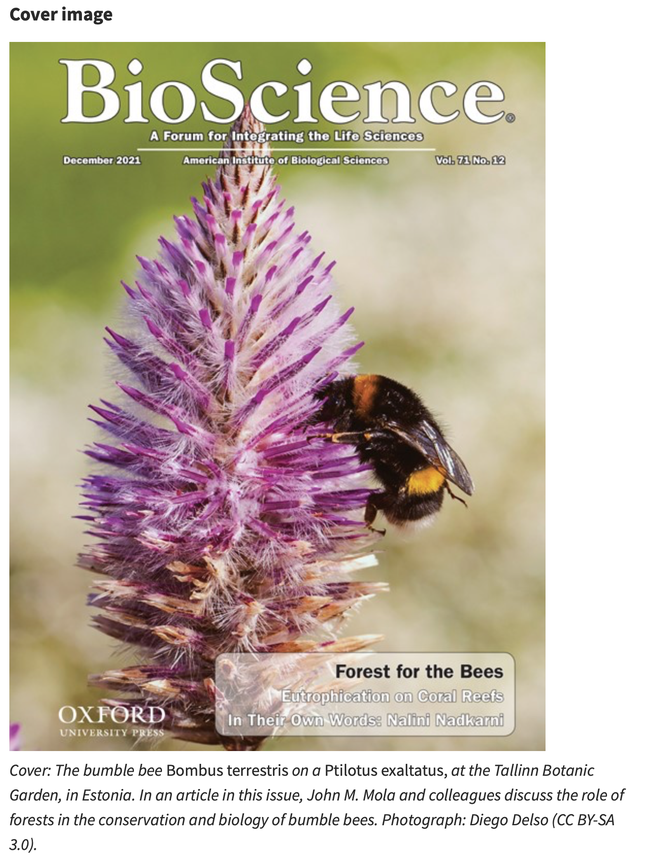- Author: Kathy Keatley Garvey
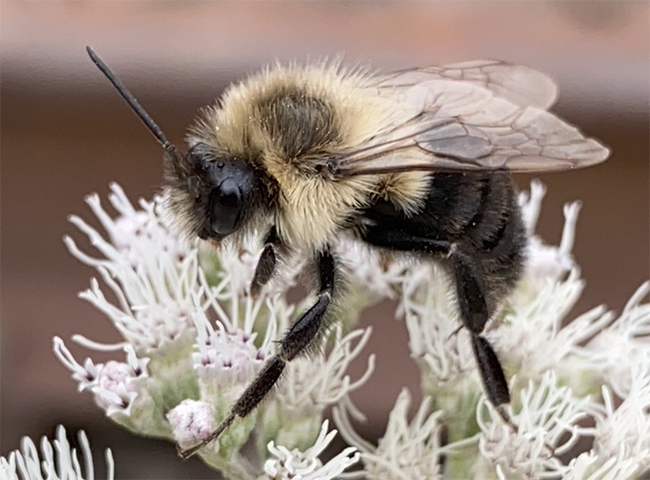
With the Entomological Society of America (ESA), however, being framed is a good thing. No, a great thing!
ESA honors its President's Prize winners (aka first-place winners) in the student research competitions by asking them to step behind a cardboard cut-out and smile for the camera. Voila! Suitable for framing!
Joe Rominiecki, ESA manager of communications, just announced that the images are now available and we have permission to share them.
We earlier wrote that doctoral candidates Danielle Rutkowski and Zachary Griebenow of the UC Davis Department of Entomology and Nematology each won the President's Prize for their individual research presentations at the 2022 Joint Meeting of the Entomological Societies of America, Canada, and British Columbia, held Nov. 13-16 in Vancouver, British Columbia.
And now, we have the images.
Background: At the annual ESA meetings, students are offered the opportunity to present their research and win prizes. They can compete in 10-minute papers (oral), posters, or infographics. The President's Prize winners receive a one-year paid membership in ESA, a $75 cash prize, and a certificate. Second-winners score a one-year free membership in ESA and a certificate.
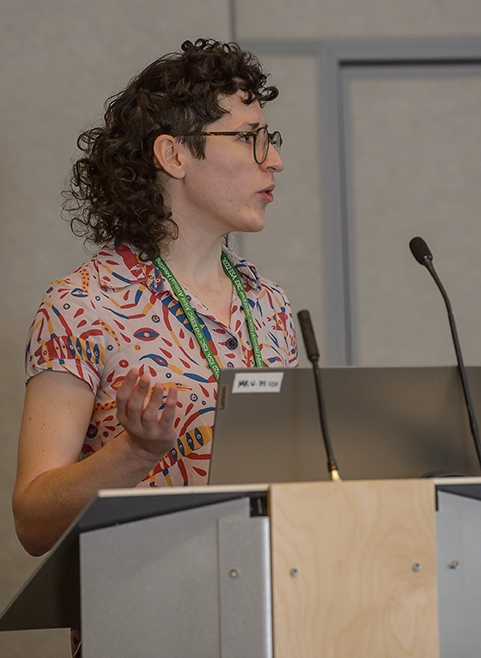
Rutkowski, who studies with community ecologists Rachel Vannette, associate professor, and distinguished professor Richard “Rick” Karban, spoke on “The Mechanism Behind Beneficial Effects of Bee-Associated Fungi on Bumble Bee Health,” at her presentation in the category, Graduate School Plant-Insect Ecosytems: Pollinators.
Her abstract: "Bees often interact with fungi, including at flowers and within bee nests. We have previously found that supplementing bumble bee colonies with these bee-associated fungi improves bee survival and increases reproductive output, but the mechanisms behind these effects are unclear. This research aimed to determine the mechanisms underlying positive impacts of fungal supplementation in the bumble bee, Bombus impatiens. We tested two hypotheses regarding possible nutritional benefits provided by bee-associated fungi. These included the role of fungi as a direct food source to bees, and the production of nutritionally important metabolites by fungi. To test these mechanisms, we created microcolonies bumble bees and exposed each microcolony to one of four treatment groups. These four treatments were created based on the presence of fungal cells and the presence of fungal metabolites. We found that bee survival and reproduction were unaffected by treatment, with trends of decreased survival and reproduction when fungi were present. This contradicts previous results we've found using this bumble bee species, where fungi had a positive impact. It is possible that this disparity in results is due to differences in pathogen pressure between the two experiments, as bees in the first experiment were exposed to large amounts of pathogen through provided pollen, including Ascosphaera and Aspergillus. This pollen was sterilized for subsequent experiments, reducing pathogen load. Therefore, it is possible that bee-associated fungi benefit bees through pathogen inhibition, and future work exploring this hypothesis is necessary to fully understand the role of these fungi in bumble bee health."
Zachary Griebenow. Griebenow, who studies with major professor and ant specialist Phil Ward, (Griebenow also captained the UC Davis Entomology Games Team in its national championship win at the Entomology Games or Bug Bowl) explained “Systematic Revision of the Obscure Ant Subfamily Leptanillinae (Hymenoptera: Formicidae), Reciprocally Informed by Phylogenomic Inference and Morphological Data.” His category: Graduate School Systematics, Evolution and Biodiversity: Evolution 1.
His abstract: "Ants belonging to the subfamily Leptanillinae (Hymenoptera: Formicidae) are sister to nearly all other extant ants. Miniscule and subterranean, little is known of their behavior. Contrary to the collecting bias observed in most ants, male leptanilline specimens are acquired more easily than workers or queens. The sexes are almost never collected in association, and many subclades within the Leptanillinae are known from male specimens only. Our comprehension of evolutionary relationships among the Leptanillinae is further obstructed by oft-bizarre derivation in male phenotypes that are too disparate for phylogeny to be intuited from morphology alone. These restrictions plague our understanding of the Leptanillinae with probable taxonomic redundancy. My thesis aims at leptanilline taxonomy that reflects phylogeny, inferred from both genotype and phenotype, and integrates morphological data from both sexes. Here I present the results of (1) phylogenomic inference from ultra-conserved elements (UCEs), compensating for potential systematic biases in these data, representing 63 terminals; and (2) Bayesian total-evidence inferences from a handful of loci, jointly with discrete male morphological characters coded in binary non-additive or multistate fashion. Notably, these analyses identify worker specimens belonging to the genera Noonilla and Yavnella, which were heretofore known only from males. Given such discoveries across the Leptanillinae, the number of valid leptanilline genera is reduced from seven to three in order to create a genus-level classification that upholds monophyly along with diagnostic utility."
We also salute our second-place winners (see previous news story:
- Lindsey Mack, who studies with medical entomologist-geneticist Geoffrey Attardo, assistant professor, covered “Three Dimensional Analysis of Vitellogenesis in Aedes aegypi Using Synchrotron X-Ray MicroCT” in the category, Graduate School Physiology, Biochemistry and Toxicology: Physiology
- Addie Abrams, who studies with Extension agricultural entomologist and assistant professor Ian Grettenberger, titled her research, “Hitting the Mark: Precision Pesticide Applications for the Control of Aphids in California Lettuce" in the category, Graduate School Physiology, Biochemistry and Toxicology: Integrated Pest Management
Congrats, all! They do our department and our university proud!
(The 7000-member ESA, founded in 1889, is the largest organization in the world serving the professional and scientific needs of entomologists and individuals in related disciplines. Its members, affiliated with educational institutions, health agencies, private industry, and government, are researchers, teachers, extension service personnel, administrators, marketing representatives, research technicians, consultants, students, pest management professionals, and hobbyists.)
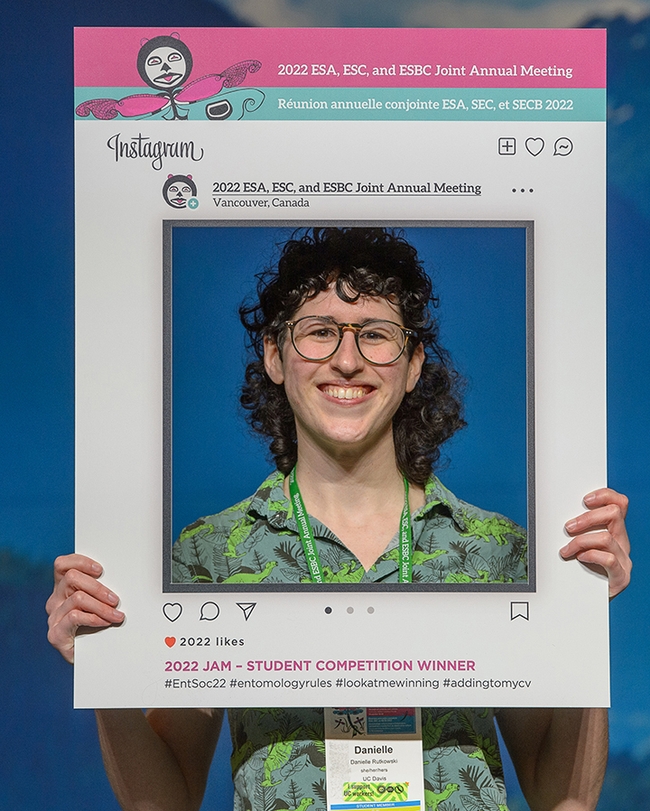
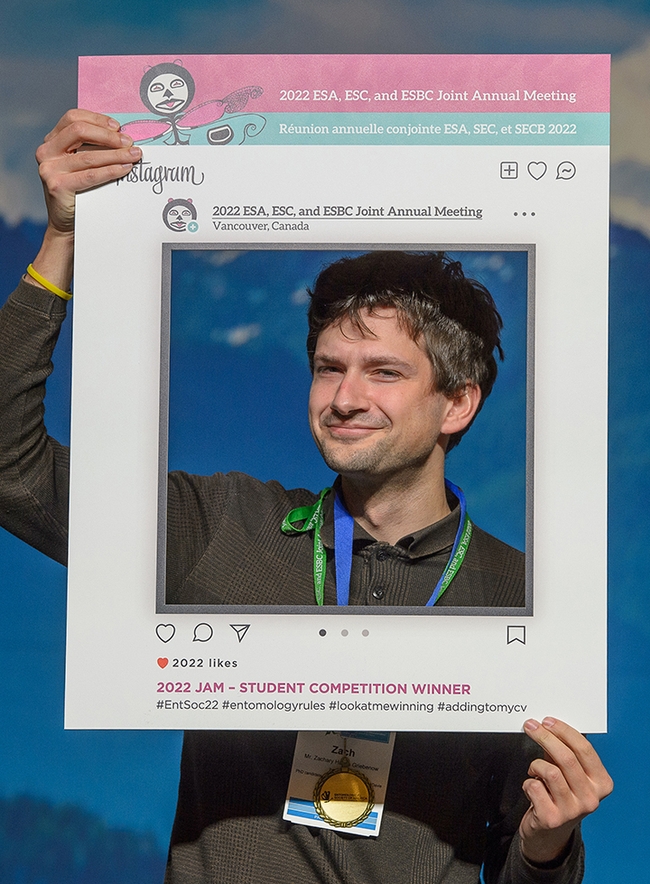
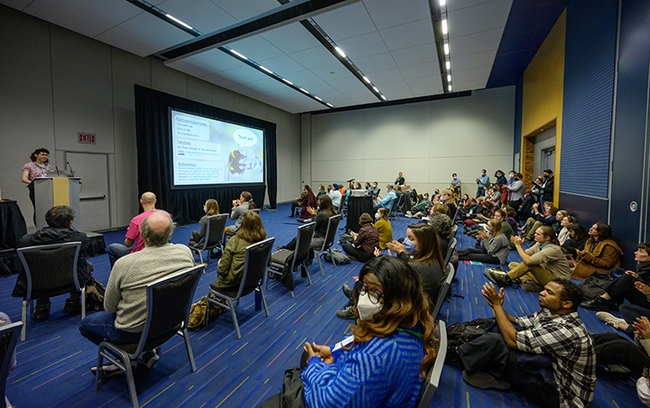
- Author: Kathy Keatley Garvey
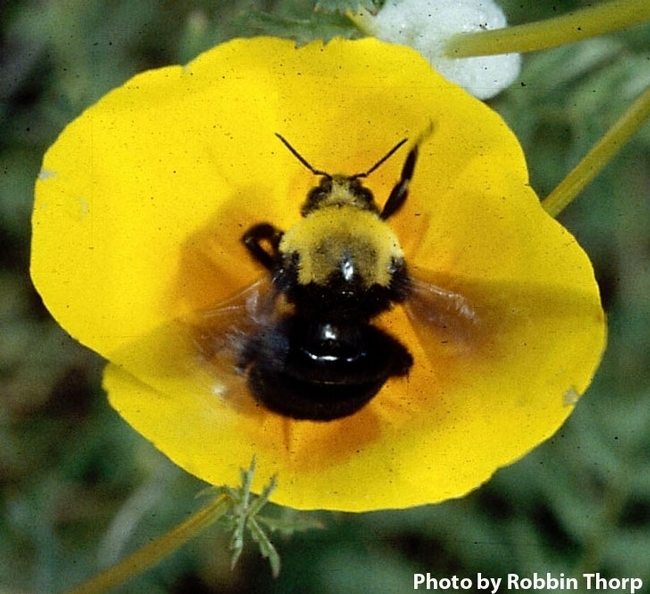
Professor Thorp (1933-2019), a 30-year member of the Department of Entomology and Nematology and a worldwide authority on bees, was a tireless advocate of bumble bee conservation. During his retirement, he co-authored Bumble Bees of North America: An Identification Guide (Princeton University, 2014) and California Bees and Blooms: A Guide for Gardeners and Naturalists (Heyday, 2014).
And every summer from 2002 to 2018, Thorp volunteered his time and expertise to teach at The Bee Course, an annual workshop sponsored by the American Museum of Natural History and held at the Southwestern Research Station, Portal, Ariz.
Thorp also served as the regional co-chair of the Wild Bee Specialist Group of the International Union for Conservation of Nature (IUCN) and sounded the alarm about bumble bee declines, including Franklin's bumble bee, Bombus franklini, found only in its narrow distribution range of southern Oregon and northern California. Thorp last saw it near Mt. Ashland in 2006 and it is is now feared extinct or at the brink of extinction. The bee inhabits--or did--a 13,300-square-mile area confined to five counties--Siskiyou and Trinity counties in California; and Jackson, Douglas and Josephine counties in Oregon.
Enter the California Bumble Bee Atlas (CBBA), a collaboration of the California Department of Fish and Wildlife (CDFW), Sacramento, and the Xerces Society for Invertebrate Conservation, headquartered in Portland, Ore. Launched in March 2022, the Atlas is a "collaborative community science effort to track and conserve the state's native bumble bee species," according to Dylan Winkler, bumble bee scientific aide for the CDFW's Wildlife Diversity Program.
Back in September 2021, the U.S. Fish and Wildlife Service announced that the American bumble bee, "whose populations have plummeted by nearly 90 percent, may warrant Endangered Species Act protection." The announcement kicked off a one-year status assessment of the species. (See news story)
If you're interested in bumble bee conservation, take note. Winkler will lead a "Bumble Bee Walk" from 10 a.m. to noon on Saturday, May 28 in the UC Davis Arboretum and Public Garden. The goal is to teach interested participants how to survey bumble bees. You can pre-register at https://arcg.is/0PDyO4. Organizers plan to cap attendance at 20 people. Details about this Atlas event and several more scheduled in June:
- Saturday, May 28: UC Davis Arboretum, Davis, CA (Yolo County), parking at Putah Creek Lodge Parking Lot, Garrod Drive, Davis, CA 95616. Tour of the native plant gardens and the forest along Putah Creek from 10 a.m. to noon.
- Saturday, June 4: The Gardens at Lake Merritt, 666 Bellevue Avenue, Oakland, CA (Alameda County). Tour of the gardens from 9 a.m. to 11 a.m.
- Sunday, June 5: College of Marin at Kentfield (Marin County), parking at covered Lots 6/7 off College Ave, Kentfield, CA 94904. Details: Meet at bridge over Corte Madera Creek. Tour of the campus native plants from 10 a.m. to noon.
- Saturday, June 18: Soil Born Farms, Rancho Cordova, CA (Sacramento County), parking at Soil Born Farms: American River Ranch, 2140 Chase Drive, Rancho Cordova, CA 95670. As part of National Pollinator Week, the group will tour the gardens from 10 a.m. to noon. Closed-toed shoes required.
Of the 50 species of bumble bees found in North America, an estimated 25 inhabit California. Overall, a quarter is at risk, according to the Atlas website. The decline is attributed to "loss or fragmentation of habitat, pesticide exposure, climate change, overgrazing, competition with honey bees, low genetic diversity, and perhaps most significant of all, the introduction and distribution of pathogens through commercial honey bee and bumble bee colonies used for crop pollination. All of these factors likely interact, increasing pollinator vulnerability. To support bumble bees, it is critical to protect existing habitat while creating and maintaining new habitat."
Winkler says "we will be using butterfly nets to catch bees, then move them to small vials, and chill them in coolers with ice, so we can take ID'able photographs of them before releasing." The full protocol is at https://www.cabumblebeeatlas.org/point-surveys.html
What bumble bees might you see May 28 in the Arboretum? Bombus vosnesenskii, the yellow-faced bumble bee, and B. melanopygus, the black-tailed bumble bee. "There is a record of B. crotchii at the arboretum from last year around the same date, which is rare and would be amazing to see!" Winkler said.
The project is funded by the U.S. Fish and Wildlife Service through the Wildlife and Sport Fish Restoration Fund. Funding is also provided by the Bureau of Land Management and several private foundations. Read more about the project and the list of coordinators here.
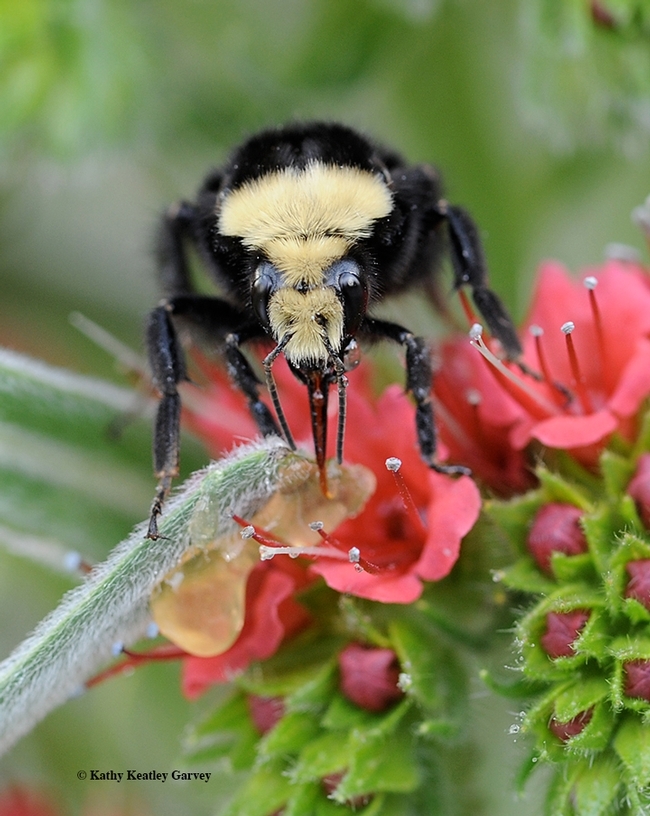
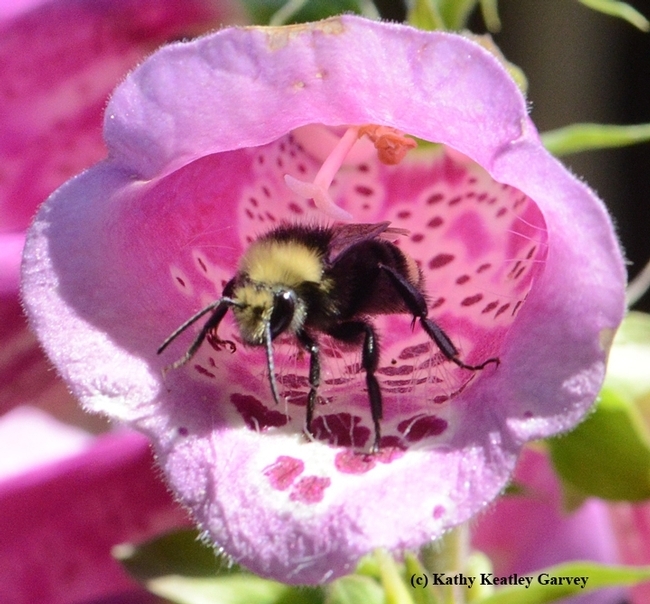
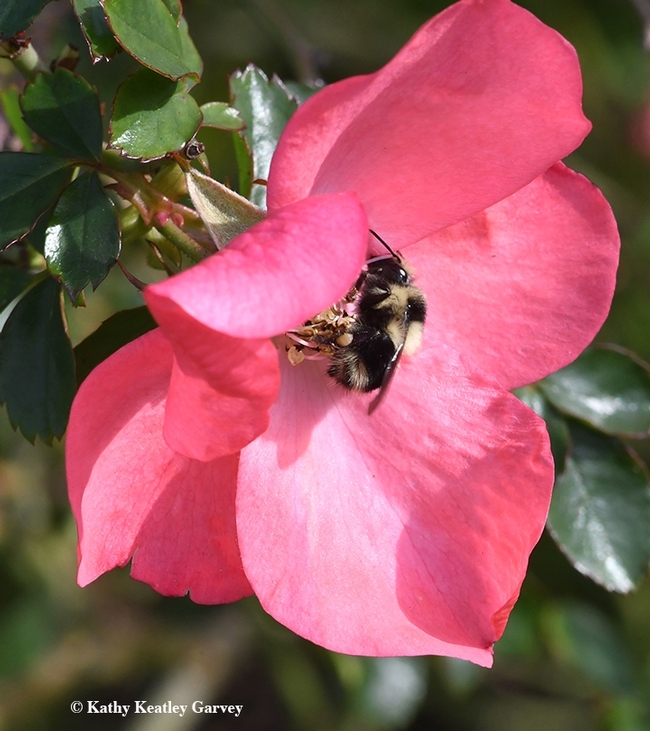
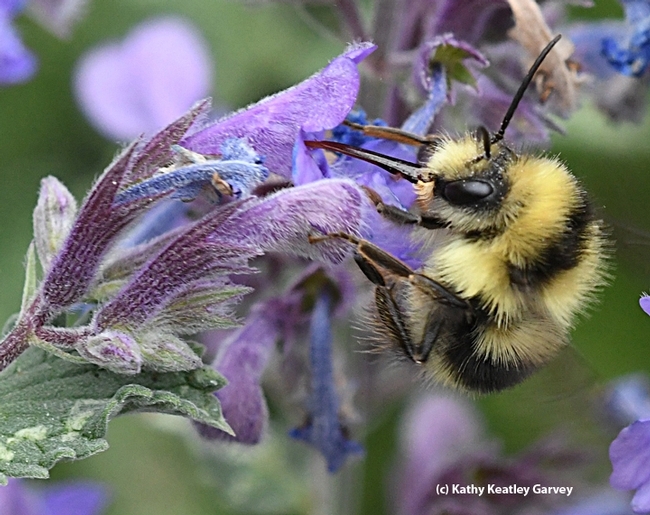
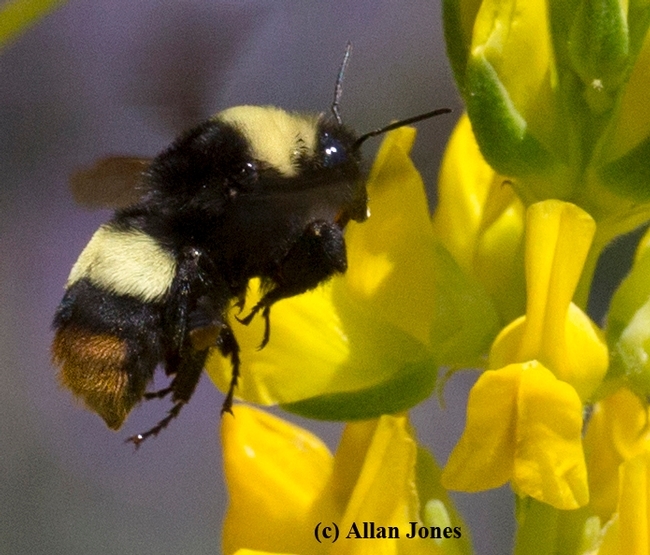
- Author: Kathy Keatley Garvey
What's better than seeing a yellow-faced bumble bee, Bombus vosnesenskii, foraging on an neon pink ice plant at Bodega Bay?
Seeing two bumble bees on the same flower.
That's what we observed on a recent trip to Doran Regional Park, Bodega Bay, Sonoma County. It was bumble bee heaven. While conservationists are removing ice plant in one area of the park, bumble bees are foraging on the flowers in another area.
B. vosnesenskii is a native. The ice plant, Carpobrotus edulis, is not. It's from South Africa. Conservationists are removing the invasive ice plant "to allow native, endangered plants to repopulate the area and wildlife to thrive."
But meanwhile, this Bombus keeps buzzing and foraging. (Bombus is derived from a Latin word meaning "buzzing.")
Bumble bees are important pollinators (think "buzz pollination" on tomatoes) but we haven't seen them much around Solano and Yolo counties this year.
Sonoma County, yes! Bodega Bay seems to be an oasis.
And speaking of bumble bees, the Bohart Museum of Entomology sponsors an annual Robbin Thorp Memorial First-Bumble-Bee-of-the-Year Contest to see who can find the first bumble bee of the year in the two-county area of Yolo and Solano.The first to photograph one and email to the Bohart Museum wins. This year UC Davis doctoral candidate Maureen Page of the Neal Williams lab, UC Davis Department of Entomology and Nematology, photographed B. melanopygus with her cell phone camera, and horticulturist Ellen Zagory, retired director of public horticulture for the UC Davis Arboretum and Public Garden, photographed B. vosnesenskii with her Sony camera.
Coincidentally, they each took their photos at exactly 2:30 p.m., Jan. 1 in the 100-acre UC Davis Arboretum and Public Garden as the bees foraged on manzanita.
They represented "a double," too--a double win.
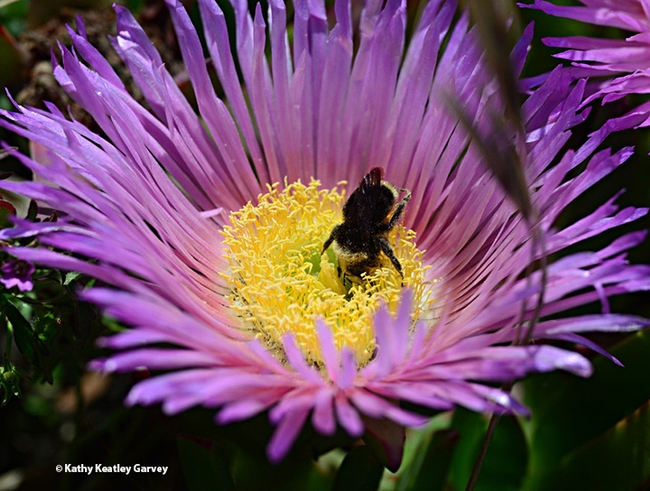
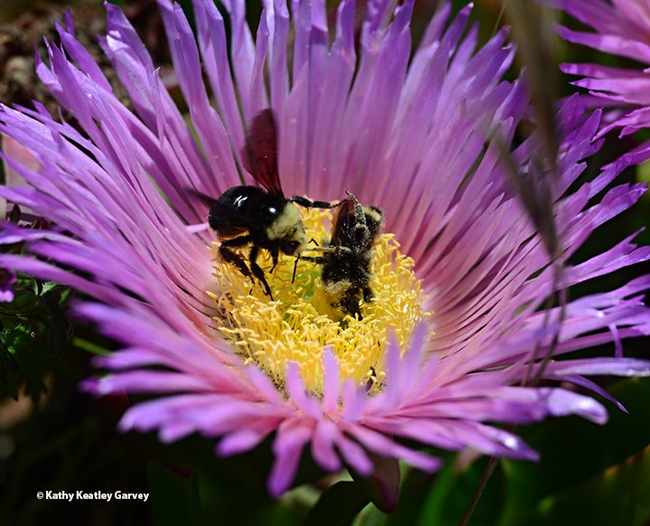
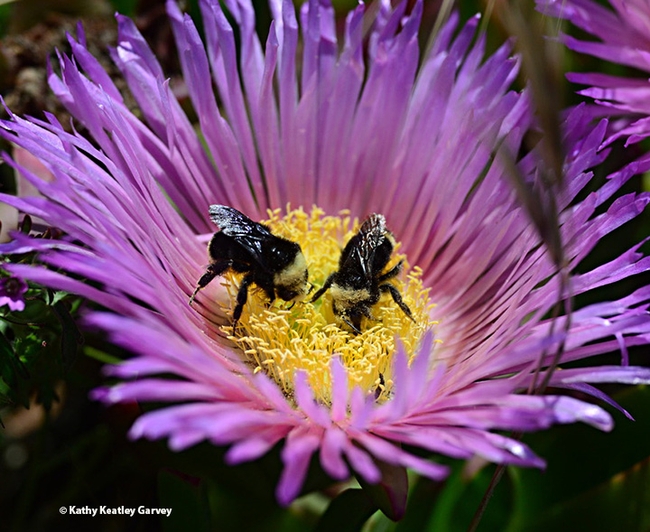
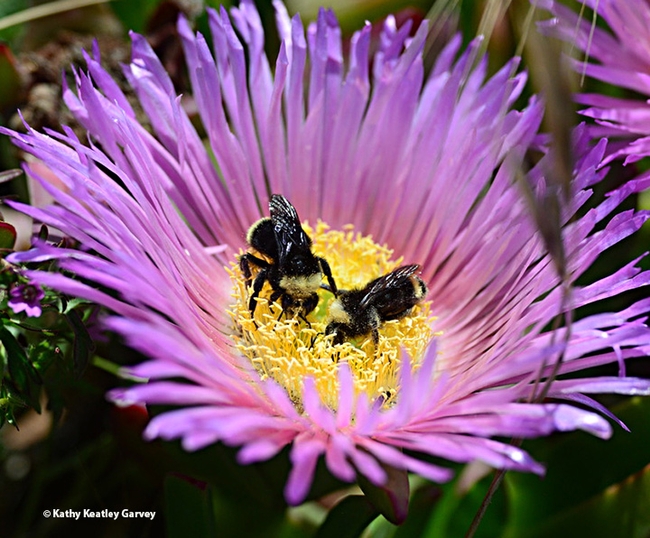
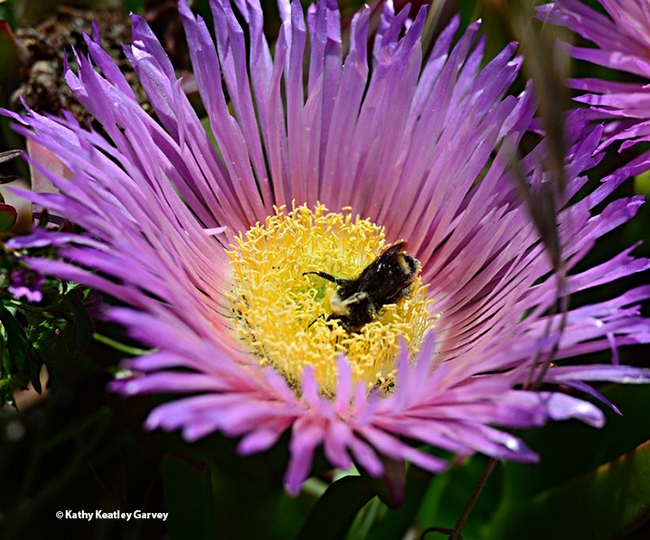
- Author: Kathy Keatley Garvey
Ever watched a bumble bee ballet?
Bumble bees may look clumsy in flight, but they get the job done.
We recently marveled at the yellow-faced bumble bees, Bombus vosnesenskii, foraging on lacy phacelia, Phacelia tanacetifolia, on the UC Davis campus.
This is a native bumble bee and a native plant.
Bumble bees do love Phacelia (think of Cecelia when you're pronouncing it--and there's probably a Cecelia out there who loves Phacelia as much as bumble bees do.)
B. vosnesenskii is native to the west coast of North America, and its range spans from British Columbia to Baja California. "The genus name Bombus--the bumblebee--comes from the Latin word which means a buzzing or humming sound, according to Wikipedia. "There are 250 species split into 38 subgenera within the genus Bombus."
Phacelia, a species in the borage family, Boraginaceae, is native to the southwestern United States and northern Mexico. In Greek, its name means means "bundle," in reference to its clustered flowers, according to Wikipedia, while tanacetifolia means "with leaves resembling those of Tanacetum."
Plant Phacelia and you'll be graced with bumble bee ballets. No ballet lessons required.
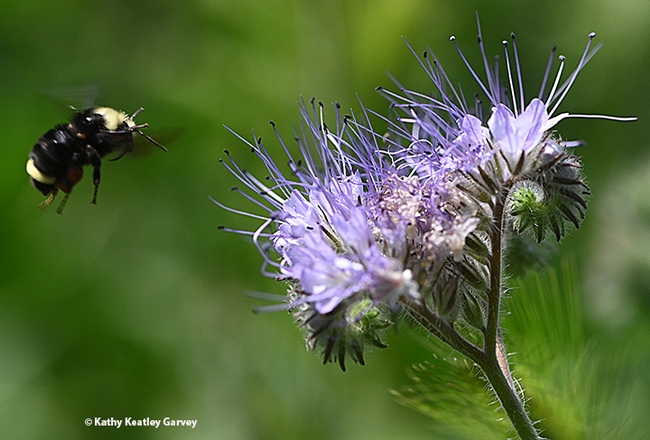
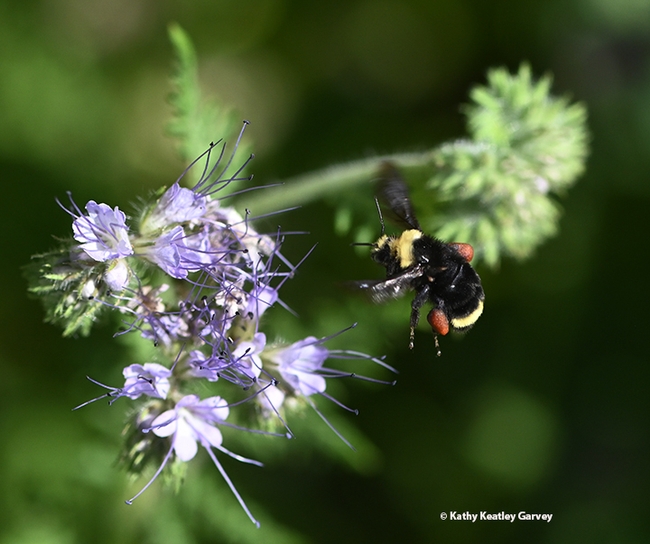
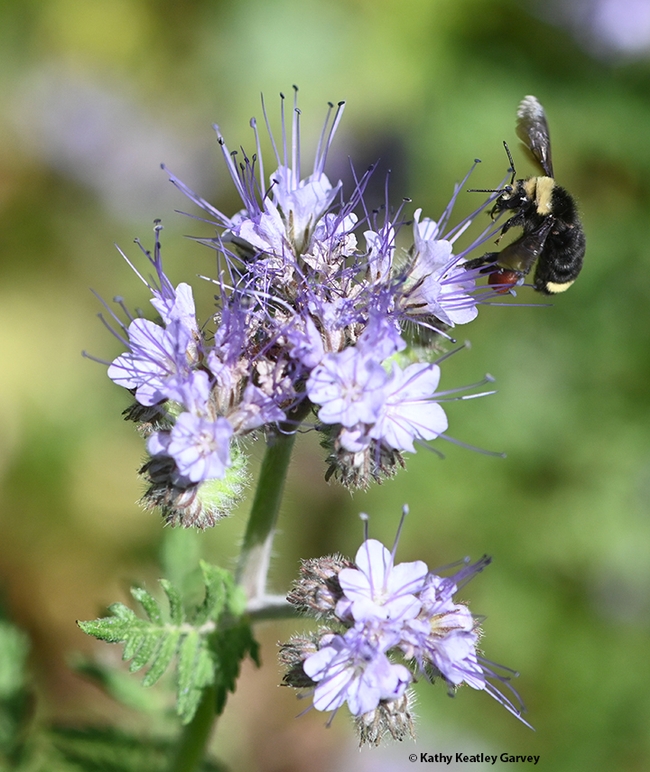
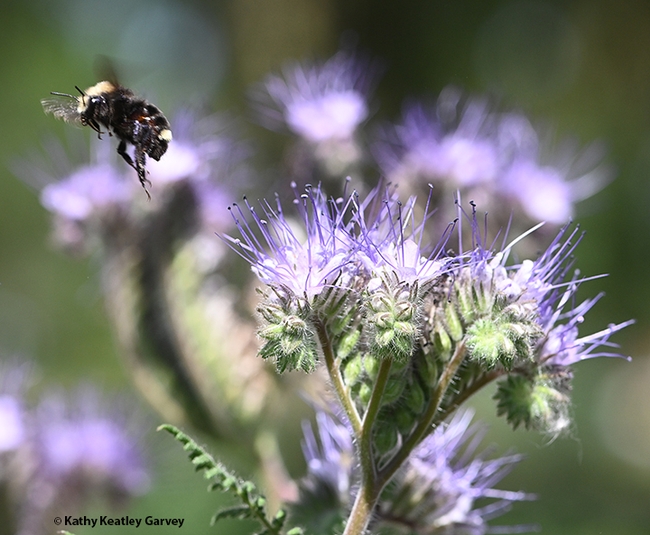
- Author: Kathy Keatley Garvey
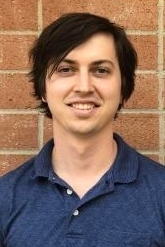
Yes, says UC Davis alumnus and research ecologist John Mola and his colleagues in a newly published article, "The Importance of Forests in Bumble Bee Biology and Conservation," the cover story in the current edition of the journal Bioscience.
"Forests are often critical bumble bee habitat," wrote Mola, a U.S. Geological Survey Mendenhall Postdoctoral Fellow based at the Fort Collins Science Center, Colorado, and a former member of the Neal Williams laboratory, UC Davis Department of Entomology and Nematology. He authored the research article with colleagues Jeremy Hemberger, a postdoctoral researcher in the Williams lab; Jade Kochanski of the University of Wisconsin, Madison; Leif Richardson of the Xerces Society for Invertebrate Conservation; and UC Davis alumnus Ian Pearse of the Fort Collins Science Center.
The cover image by Diego Delso shows a Bombus terrestris, a buff-tailed bumble bee that is one of the most numerous bumble bee species in Europe. He captured the image on a pink mulla mulla, Ptilotus exaltatus, in Estonia.
The abstract:
"Declines of many bumble bee species have raised concerns because of their importance as pollinators and potential harbingers of declines among other insect taxa. At present, bumble bee conservation is predominantly focused on midsummer flower restoration in open habitats. However, a growing body of evidence suggests that forests may play an important role in bumble bee life history. Compared with open habitats, forests and woody edges provide food resources during phenologically distinct periods, are often preferred nesting and overwintering habitats, and can offer favorable abiotic conditions in a changing climate. Future research efforts are needed in order to anticipate how ongoing changes in forests, such as overbrowsing by deer, plant invasions, and shifting canopy demographics, affect the suitability of these habitats for bumble bees. Forested habitats are increasingly appreciated in the life cycles of many bumble bees, and they deserve greater attention from those who wish to understand bumble bee populations and aid in their conservation."
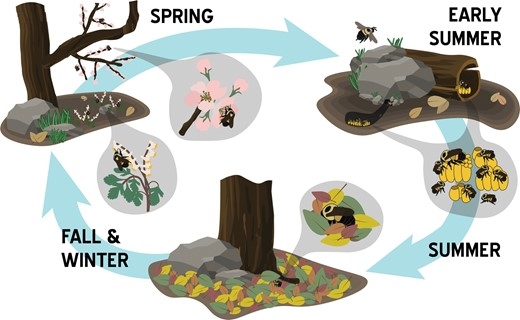
"Despite their lower numerical abundance, recent studies have shown that these phases of bumble bee life history are especially important in determining the trajectory of their populations (Crone and Williams 2016, Carvell et al. 2017)," they wrote. "Because forests in many regions contrast with open habitats in terms of their flowering phenology, structural features, and abiotic conditions, these habitats may be particularly relevant to the understudied portions of the bumble bee life cycle. When considering the bumble bee year more broadly to include early floral resources or nesting and overwintering habitat, the role of forests, forest edges, and other woody habitats becomes more central in our understanding of bumble bee biology."
They concluded: "We hope our perspective does not provide the idea that forests are required for bumble bees but instead that they offer a cost effective means to provide foraging, nesting, and overwintering habitats that are compatible with conservation goals of other organisms (Williams 2011, Bentrup et al. 2019) and may be overlooked in studies of bumble bee biology. A recurrent problem in bumble bee conservation is the lack of informed demographic models or an understanding of basic aspects of species biology (i.e., nesting and overwintering). Increasing our capacity to incorporate forests into these efforts is likely to produce rich data sets that better inform conservation efforts and lead to the development of useful demographic models."
Active in bumble bee research, Mola is an invited participant on both the Western Bumble Bee Species Status Assessment Expert Group and the Native Bee Monitoring Research Coordination Network, and is also an organizing member (since 2020) of BOMBUSS: Building Our Methods by Using Sound Science.
"The BOMBUSS mission," according to its website, "is to bring researchers working on bumble bee biology together to discuss the methodologies currently used to investigate these important pollinators. As domestication of bumble bees has expanded worldwide, so has research on this group of bees as model organisms for study, as crop pollinators, and as conservation targets. The growth of this field of study has been rapid, prompting the organizers to convene this meeting to discuss the need and potential for standardization of methods."
BOMBUSS goals are five-fold:
- to identify the areas where common methodology already exists,
- identify areas where best practices can be suggested,
- identify gaps in the literature regarding methodology,
- share knowledge and build networks for advancing our science,
- formulate plans to address the gaps through peer-reviewed publication.
Mola received his doctorate in ecology in 2019 from UC Davis. He presented his exit seminar on "Bumble Bee Movement Ecology and Response to Wildfire."
At UC Davis, Mola was a Professors for the Future Fellow, receiving a year of professional development and pedagogical training. His honors also include a 2013-2018 National Science Foundation Graduate Research Fellowship of $133,500 and a 2014-2016 UC Davis Graduate Group in Ecology Fellowship of $43,000. He won the graduate student research poster competition at the 2018 UC Davis Bee Symposium for his work on "Bumble Bee Movement and Landscape Genetics."
